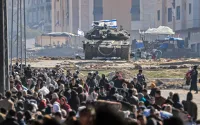15 Feb 2010Washington Post
RIPTON, VERMONT -- You want to hear my winter weather story? No, really, I know you do.
The cross-country ski race I've been training for, set for today high in the Green Mountains: cancelled, lack of snow.
Meanwhile, across the continent, backhoes and helicopters are moving snow down British Columbia's Cypress Mountain in an attempt to cover the Olympic ski courses, and technicians are burying cooling pipes beneath the moguls to keep them from melting. Some climate-conscious jokers put out a video pushing the sport of "bobwheeling" for future snow-challenged Olympiads.
And apparently there was some snowfall in the greater Washington area last week.
When you're trying to launch snowboarding tricks on dry ground and simultaneously shutting down the U.S. government because the snowbanks are casting shadows on the Washington Monument, something odd is going on. This isn't a good old-fashioned winter for the District of Columbia, not unless you're remembering the last ice age. And it doesn't disprove global warming, despite Sen. Jim De Mint's cheerful tweet: "It's going to keep snowing until Al Gore cries 'uncle.' "
Instead, the weird and disruptive weather patterns around the world are pretty much exactly what you'd expect as the planet warms. Here's how it works:
In most places, winter is clearly growing shorter and less intense. We can tell, because Arctic sea ice is melting, because the glaciers on Greenland are shrinking and because a thousand other signals send the same message. Here in the mountains of the Northeast, for instance, lakes freeze later than they used to, and sometimes not at all: Lake Champlain remained open in winter only three times during the 19th century, but it did so 18 times between 1970 and 2007.
But rising temperature is only one effect of climate change. Probably more crucially, warmer air holds more water vapor than cold air does. The increased evaporation from land and sea leads to more drought but also to more precipitation, since what goes up eventually comes down. The numbers aren't trivial -- global warming has added 4 percent more moisture to the atmosphere since 1970. That means that the number of "extreme events" such as downpours and floods has grown steadily; the most intense storms have increased by 20 percent across the United States in the past century.
So here's the thing: Despite global warming, it still gets cold enough to snow in the middle of winter. It even gets cold enough to snow in Texas and Georgia, as it did late last week. And the chances of what are technically called "big honking dumps" have increased. As Jeff Masters, the widely read weather blogger, pointed out last week, a record snowstorm requires a record amount of moisture in the air. "It is quite possible that the dice have been loaded in favor of more intense Nor'easters for the U.S. Mid-Atlantic and Northeast, thanks to the higher levels of moisture present in the air due to warmer global temperatures," he wrote.
The climatalogical climate is only part of the equation. The political climate counts, too -- and there's no question that it's harder to make legislative progress when Sen. James Inhofe's grandchildren are building an igloo next to the Capitol with a big sign that says "Al Gore's New Home." The timing here is particularly tough, for the snowstorms come against the backdrop of renewed attacks on the pillars of climate science -- charges that hacked e-mails show some researchers to be venal or that key scientists have financial ties to energy industries.
Looked at dispassionately, those political attacks essentially buttress the consensus around global warming. If that much money and attention can be aimed at the data and all anyone can find is a few mistakes and a collection of nasty e-mails, it's a pretty good sign that the science is sound (though not as good a sign as the melting Arctic). The British newspaper the Guardian just concluded a huge series on the "Climategate" e-mails with the words: "The world is still warming. Humanity is still to blame. And we still, urgently, need to do something about it."
Looked at dispassionately, the round of snowmageddons crisscrossing the mid-Atlantic carries the same message. But it's hard to be dispassionate when you're wondering, six hours of shoveling later, if there's a good chiropractor in the neighborhood and what kind of dogsled you might need to reach her.
It's almost like a test, centered on ground zero for climate-change legislation. Can you sit in a snowstorm and imagine a warming world? If you're a senator, can you come back to work and pass a bill that blunts the pace of climate change? If the answer is no, then we're really in a world of trouble.






